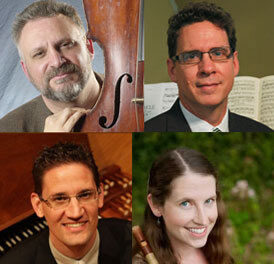“I’ve always felt that even though a man was not a Christian, he still has to know the truth some way or another. Or if he was a Christian, he could know the truth.” he said. “The truth itself doesn’t have any name on it to me. And each man has to find this for himself, I think.” Speaking these words in 1966, John Coltrane may as well have been articulating the artistic manifesto of the Turtle Island String Quartet, for there are few existing ensembles that can touch their eclectic embrace of musical styles and cultural influences. Their search for a unique musical truth has led them into unchartered territory (forays into folk, bluegrass, swing, be-bop, funk, R&B, rock, hip-hop, Latin America and Indian music), and rocketed them to the forefront of the jazz performing and recording world. The music from their most recent album A Love Supreme: The Legacy Of John Coltrane, a 2008 Grammy Award Winner for Best Classical Crossover Album, was largely featured in an entire program of tribute to this jazz great. Turtle Island founding member David Balakrishnan (violin/baritone violin), along with Mads Tolling (violin) and Mark Summer (cello) have recently welcomed a new member, violin/viola player Jeremy Kittel.
The first half of the program in Brevard’s Porter Center for the Performing Arts was announced from the stage. The opener, Balakrishnan’s Groove in the Louvre, was a transcription of a soon-to-be recorded version for guitar (written for John Jorgenson), chamber orchestra (the Nashville Symphony Orchestra), and the quartet. Inspired by a visit to Paris in which he experienced in short order, the world of high art and the infectious gypsy guitar style of Django Reinhardt, the piece is loaded with expressive aims — the styles of both Jorgenson and Reinhardt, as well as what Balakrishnan refers to as “the individuality of the heartbeat from different multicultural worlds in Paris.” Listening to this kaleidoscopic arrangement affords a typical TISQ experience. Like being on the French TGV, it’s best to be alert and at a window seat, lest you miss the quick musical references that sail by at lightning speed (e.g., Mozart’s Symphony No. 40 and, later in the program, the theme of The Simpsons).
Traditional playing methods fuse seamlessly with jazz stylings — the cellist morphs instantaneously into an amplified jazz bassist/drummer (amp turned on and off via a foot pedal), the other players alternately playing riffs and supporting rhythmic chiffs (short rhythmic downbows). The quartet’s “collectively created” Model Trane and Tolling’s arrangement of the Broadway show favorite My Favorite Things reflect Coltrane’s exploration of modes and scales in lieu of vertical, dense harmonies. Anika’s Dream, written for arts patron David Kaun by Balakrishnan, was a two-movement work opening with Bartokian dissonance and a confluence of participation, then segueing into a suave jazz movement featuring the amazing Summers as bassist/guitarist. The set ended with an energized rendition of Señor Mouse by fusion jazz great Chick Corea and evoked the set’s heartiest applause.
The second half began with Summer’s arrangement of Coltrane’s Moment’s Notice, a densely chordal piece, then Balakrishnan’s take on the impressionistic ballad Naima, deemed by Coltrane to have been his best composition. A third work followed (“NOT Coltrane, to cleanse the palate,” they said), but one featuring the Scottish fiddlings of Kittel, a US National Scottish Fiddle Champion. Holding pride-of-place was their arrangement of Coltrane’s iconic and deeply spiritual 1964 four-movement suite A Love Supreme. Its opening movement “Acknowledgment” introduces Coltrane’s 4-note heart-throb motive (to express “a love supreme”) that appears in all the movements. This behaved the most like a classical string quartet with motivic development coursing through the ensemble. “Resolution” began with a unison statement in the ensemble, a foil to the jazz groove that ensued. The final movement, “Psalm,” contained the soul of the piece in a direct and prayerful utterance. The last programmed number was Tolling’s arrangement of Stanley Clarke’s “Song to John,” a work with slower introduction and spirited section constructed on a 16-measure harmonic progression.
Turtle Island has its detractors, as their broad reach redefining what a string quartet can do/should do has their naysayers busy cataloguing their violations of traditional formal and genre lines. I found their “transgressions” to be stunningly creative (what can’t they do?), and their music making awe-inspiring and, yes, fun.











